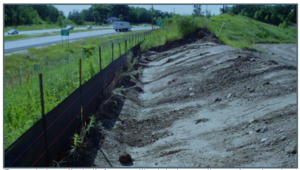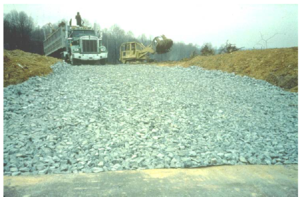
MS4 fact sheet - erosion and sediment control training
Contents
Erosion & Sediment Control Training
Developing erosion and sediment control training programs
Erosion and sedimentation is the natural process in which soil and rock material is weathered and carried away by wind, water or ice. Construction activities can increase erosion by removing vegetation, disturbing soil and exposing sediment to the elements. Eroded soil quickly becomes a sedimentation problem when wind and rain carry the soil off the construction site and sediment is deposited in surface waters.
Erosion and sediment control BMPs are necessary at all construction sites to keep soil onsite and prevent unnecessary water pollution. Training individuals responsible for installing, constructing, repairing, maintaining and/or inspecting erosion and sediment control measures and post-construction stormwater management practices at construction sites will result in properly designed, installed and maintained BMPs, improved compliance with permit regulations, and protecting water quality. This fact sheet provides guidance on developing erosion and sediment control training programs.
Benefits / Pollution Reduction
The NPDES/SDS permit for construction stormwater requires that sediment and erosion control BMPs be used on any construction site that disturbs one acre or more of land, however, these BMPs should be installed and utilized on every construction site to prevent erosion and decrease the amount of sediment leaving the site. Sedimentation build-up decreases water levels, negatively impacts water clarity, and destroys aquatic vegetation and habitat resulting in poor water quality.
In addition, the NPDES/SDS permit requires training for any individual performing the following tasks:
- Preparing the stormwater pollution prevention plans (SWPPP)
- Overseeing implementation of, revising, and amending the SWPPP and performing inspections as required in Part IV.E. of the permit
- Performing or supervising the installation, maintenance and repair of erosion and sediment control best management practices
Program Development & Implementation
Training construction and landscaping staff, contractors, and all other persons responsible for BMPs on the importance of using proper design, installation and maintenance techniques improves the chances that BMPs are performing optimally as well as ensures that construction sites are in compliance with state regulations.
Erosion and Sediment Control Training Programs
Many training programs, workshops, and seminars are offered throughout the state of Minnesota. These programs may be advertised and promoted by MS4s to encourage attendance by staff as well as local contractors, project managers, engineers, and construction workers.
The MPCA partners with the University of Minnesota to offer various certification courses to meet the training requirements of the NPDES/SDS permit for construction stormwater. The Minnesota Department of Transportation (MnDOT) requires all individuals working on MnDOT projects to be certified in the courses and to repeat the courses every three years. Information about the certification courses can be found here.
The University of Minnesota Extension Stormwater U also offers workshops throughout the year on various stormwater and erosion and sediment control topics. Additionally, the Minnesota Erosion Control Association (MECA) offers workshops and seminars providing valuable training for inspectors, project managers, contractors and designers.
Training Topics
Training programs may vary from formal classroom settings to independent study and testing, to hands-on site work experience. No matter how training occurs, the following are suggested components of a good training program.
Erosion and sediment control fundamentals A training course should include an explanation of what erosion is, how it happens, and how it relates to water quality. This will provide some background and explanation as to why properly maintained and functioning erosion and sediment control BMPs are so important in protecting water quality.
NPDES requirements and the MPCA’s permit process The MPCA regulates construction stormwater discharges through the NPDES/SDS Permit for Construction Stormwater Program. Any construction site that disturbs one acre or more of land is required to obtain a permit from the MPCA. The permit process includes a permit application and the development of a stormwater pollution prevention plan (SWPPP). The SWPPP is required to have documentation of all sediment and erosion control BMPs in an erosion control plan that will be used on the construction site.
The permit includes maintenance requirements for BMPs as well as specific inspection requirements. Instruction on all of the permit requirements and the permit process as well as assistance with developing a comprehensive SWPPP and erosion control plan should be included in a sediment and erosion control training course.
Permanent and temporary erosion and sediment control BMPs When training individuals, it is important to include information about proper design, installation, inspection, and maintenance for each type of BMP. It is also helpful to include specific product examples as well as specific examples of implementation, both successful and not successful.
There are many types of erosion and sediment controls that could be covered in a training program. The following is a condensed list of recommended BMPs to discuss in a training program.
- Site phasing
- Construction entrances
- Protecting natural vegetation and undisturbed areas
- Low impact development
- Temporary diversions
- Temporary down drains
- Sediment retention basins
- Dewatering
- Perimeter control
- Stockpile protection
- Surface roughening and slope tracking
- Minimize slopes
- Stormdrain inlet protection
- Outlet protection
- Temporary and permanent stabilization
- Specific BMPs related to working near or around water

